Research and Application of the Synergistic Support System of “LDAGF” in an Extremely Soft and Fragile Fully Mechanized Caving Face Roadway
Abstract
1. Introduction
2. Engineering Background
2.1. Engineering Profile
2.2. Laboratory Tests
2.2.1. X-ray Diffraction Analysis
2.2.2. Strength Experiments for Coal and Rock Mass
2.3. Cause Analysis on Roadway Instability
- (1)
- The SR is of low strength. According to the strength tests on coal and rock mass, the 8# coal seam corresponds to a uniaxial compressive strength of about 2.23 MPa, with its tensile strength being around 0.45 MPa. Consequently, it breaks easily under high-stress conditions, which is unconducive to the stability of the FMCFR.
- (2)
- The bearing capacity of coal is not fully utilized. According to the previous deformation monitoring tests on the ESFFMCFR, the average vertical and horizontal convergence values are 729 mm and 547 mm, respectively, with the average variation rates being 19.8 mm/d and 17.9 mm/d, respectively. This suggests that the present ESFFMCFR can hardly utilize its own bearing capacity of SR.
- (3)
- The original support fails to seal the roadway surface, and the coal body at the head and on the roadway surface breaks and falls easily. Since the SR of the ESFFMCFR softens easily and is seriously fragmented, coal at the head and on the roadway surface often breaks and falls, affecting the normal roadway excavation and support, even causing roadway instability. As a result, the roadway needs to be repaired frequently.
- (4)
- The original support strength is insufficient. At present, the support of U-shaped steel sheds and anchor bolts is used for the ESFFMCFR. However, such support fails to maximize the bearing capacity of coal and cannot be applied to the ESFFMCFR in the long term. Moreover, it has the following defects: high roadway maintenance cost, great workload in repairment and proneness of roadway instability.
3. Synergistic Support System of “LDAGF”
3.1. Principle of the Synergistic Support System
- (1)
- “L”—floor breaking and side lowering: According to the dip angle of the coal seam, reasonable floor breaking and side lowering is carried out to ensure that the shed legs at the two sides take root firmly and improve the lithologic strength at the roadway sides.
- (2)
- “D”—bolt advance support: Advance roof protection by self-drilling bolts for grouting is conducted along the roof of the shed beam. Then, the roof is grouted for solidification and the prevention of air leakage and roof caving.
- (3)
- “A”—anchor cable support: To improve the strength of the roadway support and enhance the stability of the flat-roof U-shaped steel shed support, anchor cables are used instead of bolts. The roof and sides are strengthened with long anchor cables and short cables, respectively.
- (4)
- “G”—advance water injection and grouting: To enhance the plasticity of the coal body, the coal body at the head undergoes advance water injection while the roof is solidified by advance grouting before shed establishment with the aid of advance self-drilling bolts for grouting.
- (5)
- “F”—flat-roof U-shaped steel shed support: Flat-roof U-shaped steel sheds can provide high-strength rigid support because they boast good mechanical properties and high tensile and compressive strength. In addition, a flat roof is conducive to supporting the advance support of roadway during working face recovery, hence improving the recovery efficiency.
3.2. Characteristics of the Synergistic Support System of “LDAGF”
- (1)
- The bearing capacities of different support forms are complementary: Before roadway excavation, advance bolt grouting can effectively ensure the integrity of roadway roof SR with a simple construction process. The installation of flat-roof U-shaped steel sheds and anchor cables soon after roadway excavation not only provides large support resistance but also utilizes the anchor cables so that the SR deformation slowly acts on the steel sheds. Moreover, it can make up for the low resistance of conventional anchor mesh shotcrete support, and realize the complementarity of various support forms in bearing capacity, so as to achieve the best support effect.
- (2)
- The synergistic support system and the SR are integrated to play a bearing role: Before roadway excavation, advance water injection and grouting can enhance the plasticity of the coal body while advance grouting can solidify the roof and improve the integrity of the roadway and the head. Compared with anchor bolts, anchor cables can anchor into deep and stable rock strata, transfer the additional load from the shallow SR to the deep SR and make the SR a three-way compression-bearing body by applying a large preload. On this basis, anchor cables are adopted to fix the flat-roof U-shaped steel sheds. Hence, the synergistic support system can realize an omni-directional overall bearing of deep and shallow SR both before and after excavation.
- (3)
- The one-time permanent support of SR is realized: It can avoid repeated renovation of roadways and realize one-time permanent support. Underground monitoring reveals that the ESFFMCFR supported by the synergistic support system can fully mobilize the bearing capacity of SR and realize ventilation and transportation for a long time without regular renovation, thus saving the roadway support cost to a certain extent and yielding remarkable economic benefits.
4. Engineering Application
4.1. Design for the Construction of the Synergistic Support System of “LDAGF”
- (1)
- “L”—floor breaking and side lowering
- (2)
- “D”—bolt advance support
- (3)
- “G”—advance water injection and grouting in the roadway
- (4)
- “F”—flat-roof U-shaped steel shed support in the roadway
- (5)
- “A”—anchor cable support in the roadway
4.2. Support Test of the FMCFR in the 8# Coal Seam of XH Coal Mine
- (1)
- Analysis of the Monitored Data on the Mine Pressure
- (2)
- Evaluation on the Support Effect
4.3. Support Test on the FMCFR in the 8# Coal Seam of GB Coal Mine
- (1)
- Analysis on the Monitored Data of the Mine Pressure
- (2)
- Evaluation on the Support Effect
5. Conclusions
- (1)
- The roof and two sides consist of extremely soft and fragile coal bodies. Therefore, in the SR of the FMCFR, fractures are developed and the support requires a high capacity. Conventional support systems can hardly control SR deformation. The extremely soft and fragile SR in the FMCFR and the mutual independence between the support and the SR are the primary reasons for the roadway instability.
- (2)
- This study is based on the synergistic mechanism of support and SR as well as the basic principles of synergetics. By enhancing the properties of roadway SR, improving the SR environment and promoting the support strength, the roadway can achieve an omni-directional overall bearing of deep and shallow SR both before and after excavation. Meanwhile, the generation and development of micro-cracks in the head and roadway SR are inhibited, and the spatially mutual support of the roadway and SR is enhanced. Finally, a synergistic support system of “LDAGF” for the ESFFMCFR is proposed.
- (3)
- On-site applications have shown that the synergistic support system for the ESFFMCFR can overcome the defects of a loose supporting structure and serious SR deformation in conventional support, improve the distribution law of stress of the head and plastic zone in the ESFFMCFR, effectively prevent the development of tangential fractures, and considerably improve the integrity and bearing capacity of roadway SR. This synergistic support system boasts an excellent roadway support effect and is of great guiding significance for similar roadways.
Author Contributions
Funding
Institutional Review Board Statement
Informed Consent Statement
Data Availability Statement
Conflicts of Interest
References
- Wang, H.; Jiang, C.; Zheng, P.; Li, N.; Zhan, Y. Deformation and Failure Mechanism of Surrounding Rocks in Crossed–roadway and Its Support Strategy. Eng. Fail. Anal. 2020, 116, 104743. [Google Scholar] [CrossRef]
- Li, Q.; Shi, W.; Yang, R. Deformation Mechanisms in a Coal Mine Roadway in Extremely Swelling Soft Rock. Springerplus 2016, 5, 1310. [Google Scholar] [CrossRef]
- Jing, H.; Wu, J.; Yin, Q.; Wang, K. Deformation and Failure Characteristics of Anchorage Structure of Surrounding Rock in Deep Roadway. Int. J. Min. Sci. Technol. 2020, 30, 593–604. [Google Scholar] [CrossRef]
- Chen, D.; Zhang, Q.; Xie, S.; Jiang, Z.; Li, Y.; Gao, M.; Li, H.; Wu, X.; Wang, E.; Shi, S.; et al. Combined Support Technology for Main Roadway Passing Through Goaf: A Case Study. Energy Sci. Eng. 2020, 8, 3925–3941. [Google Scholar] [CrossRef]
- An, Y.; Zhang, N.; Zhao, Y.; Xie, Z. Field and Numerical Investigation on Roof Failure and Fracture Control of Thick Coal Seam Roadway. Eng. Fail. Anal. 2021, 128, 105594. [Google Scholar] [CrossRef]
- Xu, X.; He, F.; Li, X.; He, W. Research on Mechanism and Control of Asymmetric Deformation of Gob Side Coal Roadway with Fully Mechanized Caving Mining. Eng. Fail. Anal. 2021, 120, 105097. [Google Scholar] [CrossRef]
- Wang, W.; Pan, Y.; Xiao, Y. Synergistic Mechanism and Technology of Cable Bolt Resin Anchoring for Roadway Roofs with Weak Interlayers. Rock Mech. Rock Eng. 2022, 55, 3451–3472. [Google Scholar] [CrossRef]
- Wang, T.; Chang, J.; Yin, Z.; Gong, P.; Shi, W.; Li, N. Theory and Full-scale Simulation Testing of the Mechanical Properties of Anchors Under a Variable Lateral Pressure Coefficient. Arab. J. Geosci. 2021, 14, 1–9. [Google Scholar] [CrossRef]
- Ma, S.; Liu, X.; Gutierrez, M. Critical Issues for the Ground Control of Shallow Roadways in Weak Ground: A Case Study. Arab. J. Geosci. 2020, 13, 623. [Google Scholar] [CrossRef]
- Cao, J.; Zhang, N.; Wang, S.; Wei, Q. Investigation of Mechanical Properties for Group Anchors. Appl. Sci. 2021, 11, 1521. [Google Scholar] [CrossRef]
- Yan, H.; Zhang, J.X.; Ding, Z.W.; Huang, Y.L. Surrounding Rock Deformation Mechanism of Roadways with Extra-thick Coal Seam. Disaster Adv. 2014, 6, 226–233. [Google Scholar]
- Jiao, Y.Y.; Song, L.; Wang, X.Z.; Adoko, A.C. Improvement of the U-shaped Steel Sets for Supporting the Roadways in Loose Thick Coal Seam. Int. J. Rock Mech. Min. Sci. 2013, 60, 19–25. [Google Scholar] [CrossRef]
- Ma, Z.; Liang, X.; Fu, G.; Zou, Y.; Chen, A.; Guan, R. Experimental and Numerical Investigation of Energy Dissipation of Roadways with Thick Soft Roofs in Underground Coal Mines. Energy Sci. Eng. 2021, 9, 434–446. [Google Scholar] [CrossRef]
- Xie, S.; Wu, X.; Chen, D.; Sun, Y.; Wang, E.; Wu, X.; Duan, X.; Jiang, Z.; Qi, P.; Shi, S. Failure Mechanism and Control Technology of Thick and Soft Coal Fully Mechanized Caving Roadway under Double Gobs in Close Coal Seams. Shock Vib. 2020, 2020, 8846014. [Google Scholar] [CrossRef]
- Yang, D.W.; Ma, Z.G.; Qi, F.Z.; Gong, P.; Liu, D.P.; Zhao, G.Z.; Zhang, R.R. Optimization Study on Roof Break Direction of Gob-side Entry Retaining by Roof Break and Filling in Thick-layer Soft Rock Layer. Geomech. Eng. 2017, 13, 195–215. [Google Scholar]
- Gu, S.; Jiang, B.; Wang, G.; Dai, H.; Zhang, M. Occurrence Mechanism of Roof-Fall Accidents in Large-Section Coal Seam Roadways and Related Support Design for Bayangaole Coal Mine, China. Adv. Civ. Eng. 2018, 2018, 6831731. [Google Scholar] [CrossRef]
- Zhan, Q.; Zheng, X.; Du, J.; Xiao, T. Coupling Instability Mechanism and Joint Control Technology of Soft-Rock Roadway with a Buried Depth of 1336 m. Rock Mech. Rock Eng. 2020, 53, 2233–2248. [Google Scholar] [CrossRef]
- Yang, X.; Wang, E.; Wang, Y.; Gao, Y.; Wang, P. A Study of the Large Deformation Mechanism and Control Techniques for Deep Soft Rock Roadways. Sustainability 2018, 10, 1100. [Google Scholar] [CrossRef]
- Wu, Y.B.; Hu, J.H.; Zhang, X.Y.; Qin, Y.G.; Zhang, Z.B.; Zhao, X.C. Study on Bearing Capacity Characteristics of Steel Structure Support in Soft Rock Roadway. Energy Sci. Eng. 2021, 9, 2423–2433. [Google Scholar] [CrossRef]
- Li, G.; Ma, F.; Guo, J.; Zhao, H.; Liu, G. Study on Deformation Failure Mechanism and Support Technology of Deep Soft Rock Roadway. Eng. Geol. 2020, 264, 105262. [Google Scholar] [CrossRef]
- Wang, H.; Zheng, P.Q.; Zhao, W.J.; Tian, H.M. Application of A Combined Supporting Technology with U-shaped Steel Support and Anchor-grouting to Surrounding Soft Rock Reinforcement in Roadway. J. Cent. South Univ. 2018, 25, 1240–1250. [Google Scholar] [CrossRef]
- Wu, A.; Chen, S.; Wang, Y.; Chen, X. Failure Mechanism and Supporting Measures for Large Deformation of Soft Rock Roadway in Baluba Copper Mine. Arch. Min. Sci. 2018, 63, 449–464. [Google Scholar] [CrossRef] [PubMed]
- Yu, K.; Ren, F.; Puscasu, R.; Lin, P.; Meng, Q. Optimization of Combined Support in Soft-rock Roadway. Tunn. Undergr. Space Technol. 2020, 103, 103502. [Google Scholar] [CrossRef]
- Zhao, C.; Li, Y.; Liu, G.; Meng, X. Mechanism Analysis and Control Technology of Surrounding Rock Failure in Deep Soft Rock Roadway. Eng. Fail. Anal. 2020, 115, 104611. [Google Scholar] [CrossRef]
- Skrzypkowski, K.; Zagórski, K.; Zagórska, A.; Apel, D.B.; Wang, J.; Xu, H.; Guo, L. Choice of the Arch Yielding Support for the Preparatory Roadway Located near the Fault. Energies 2022, 15, 3774. [Google Scholar] [CrossRef]

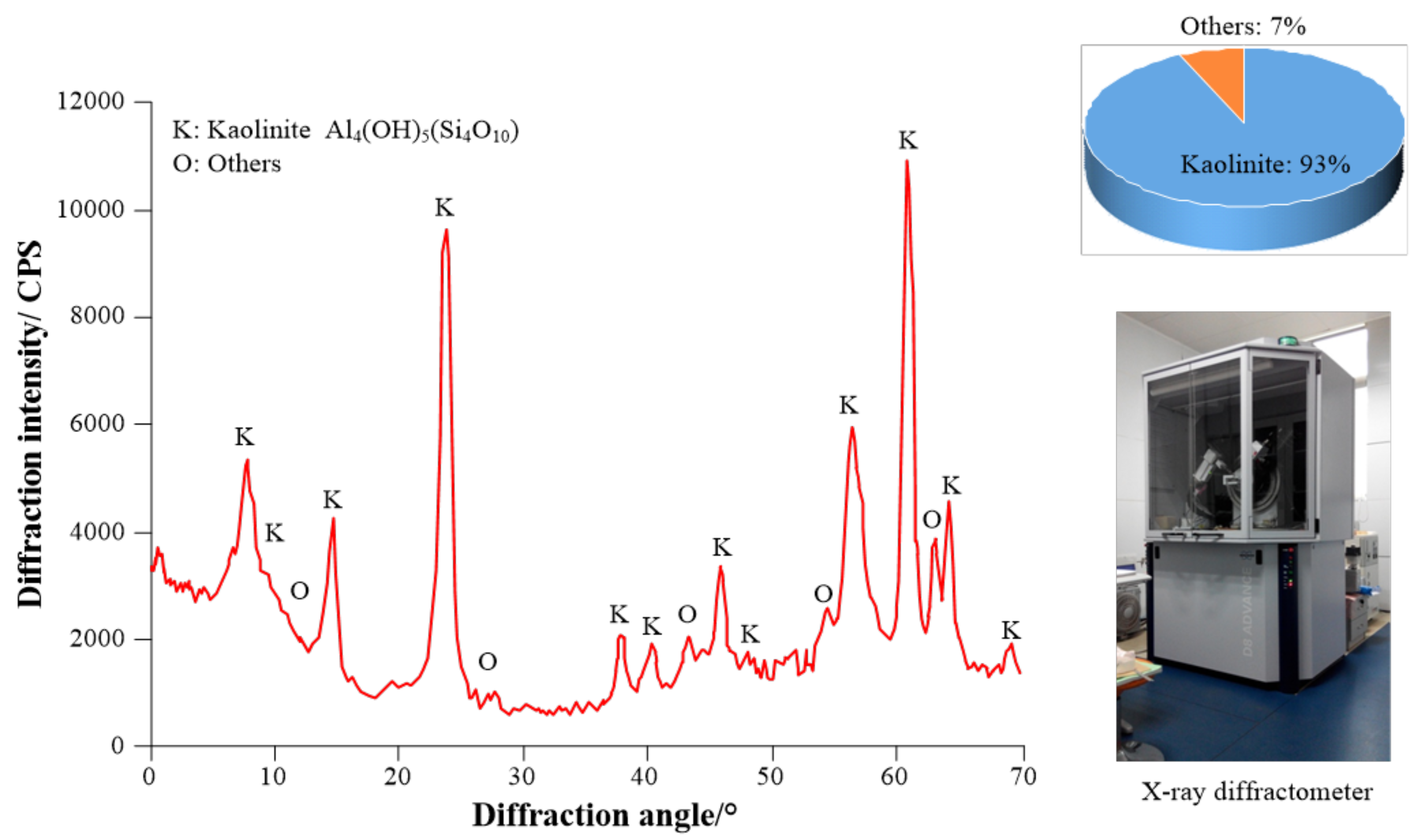
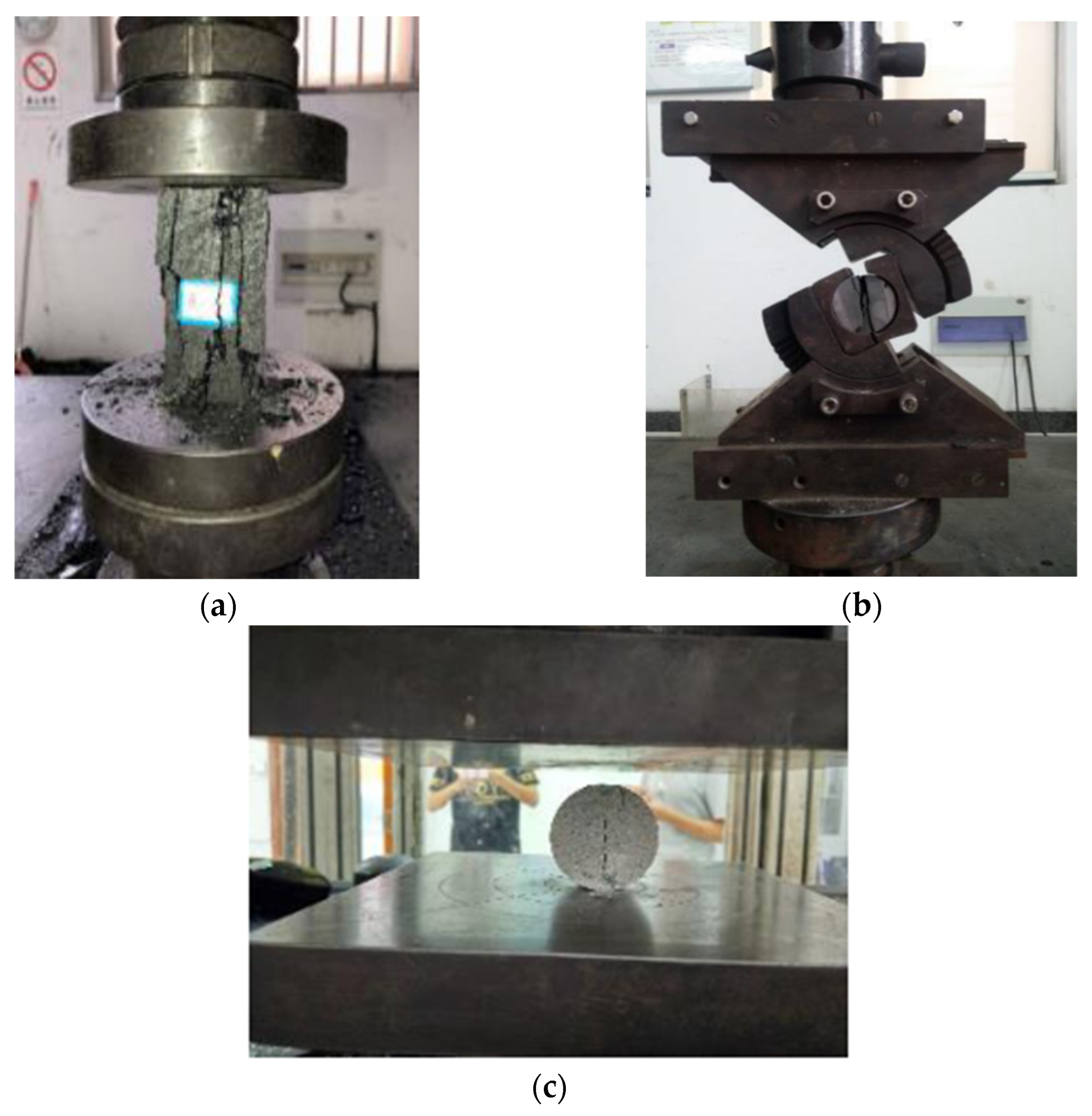
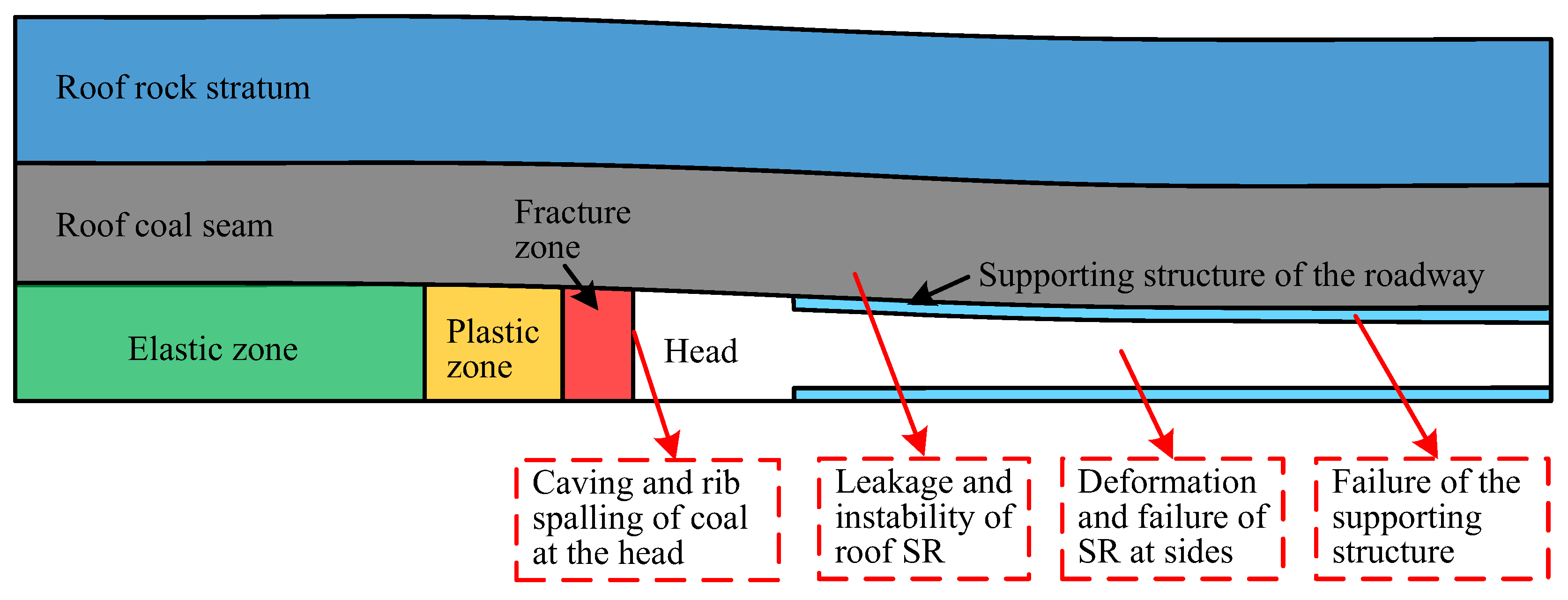

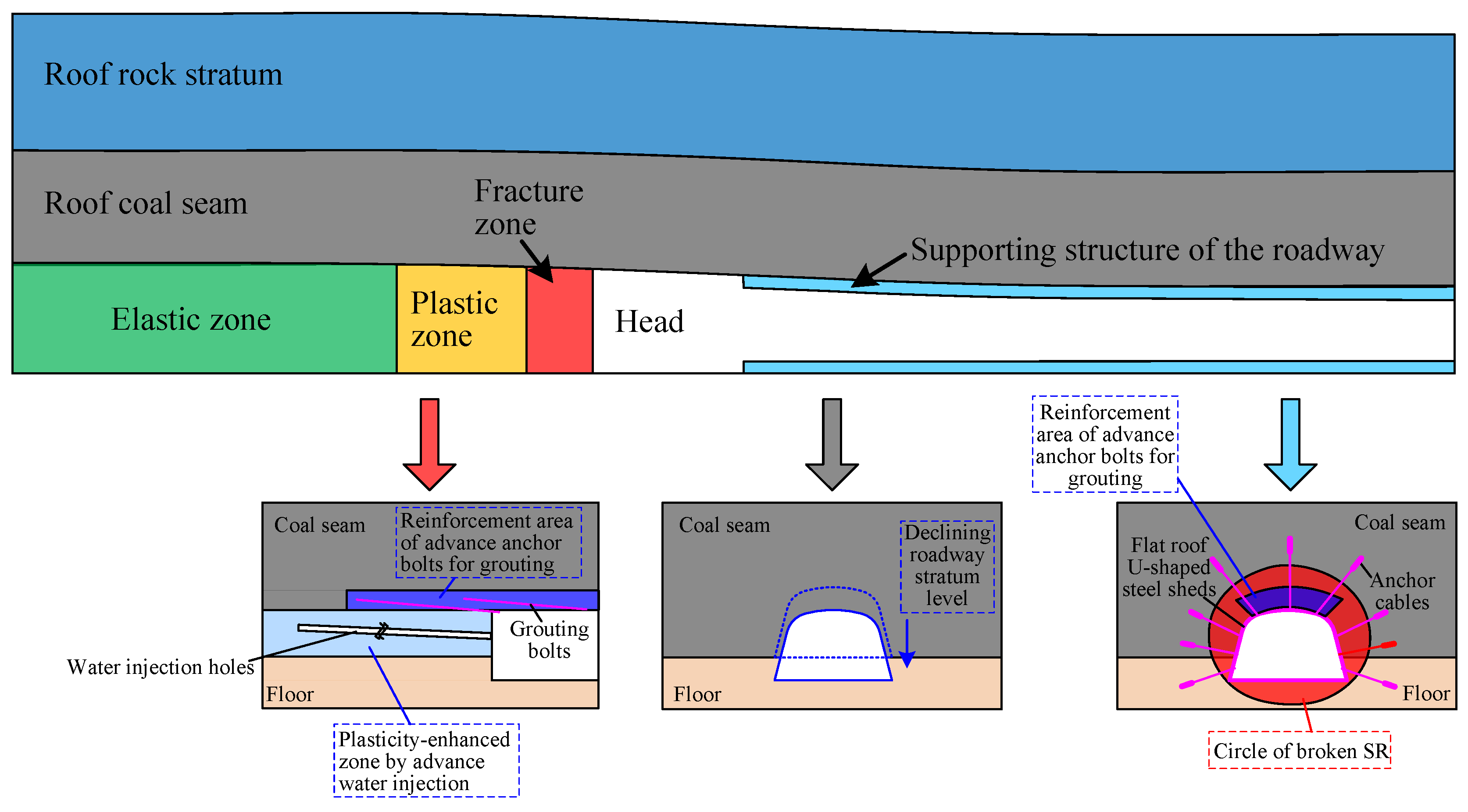
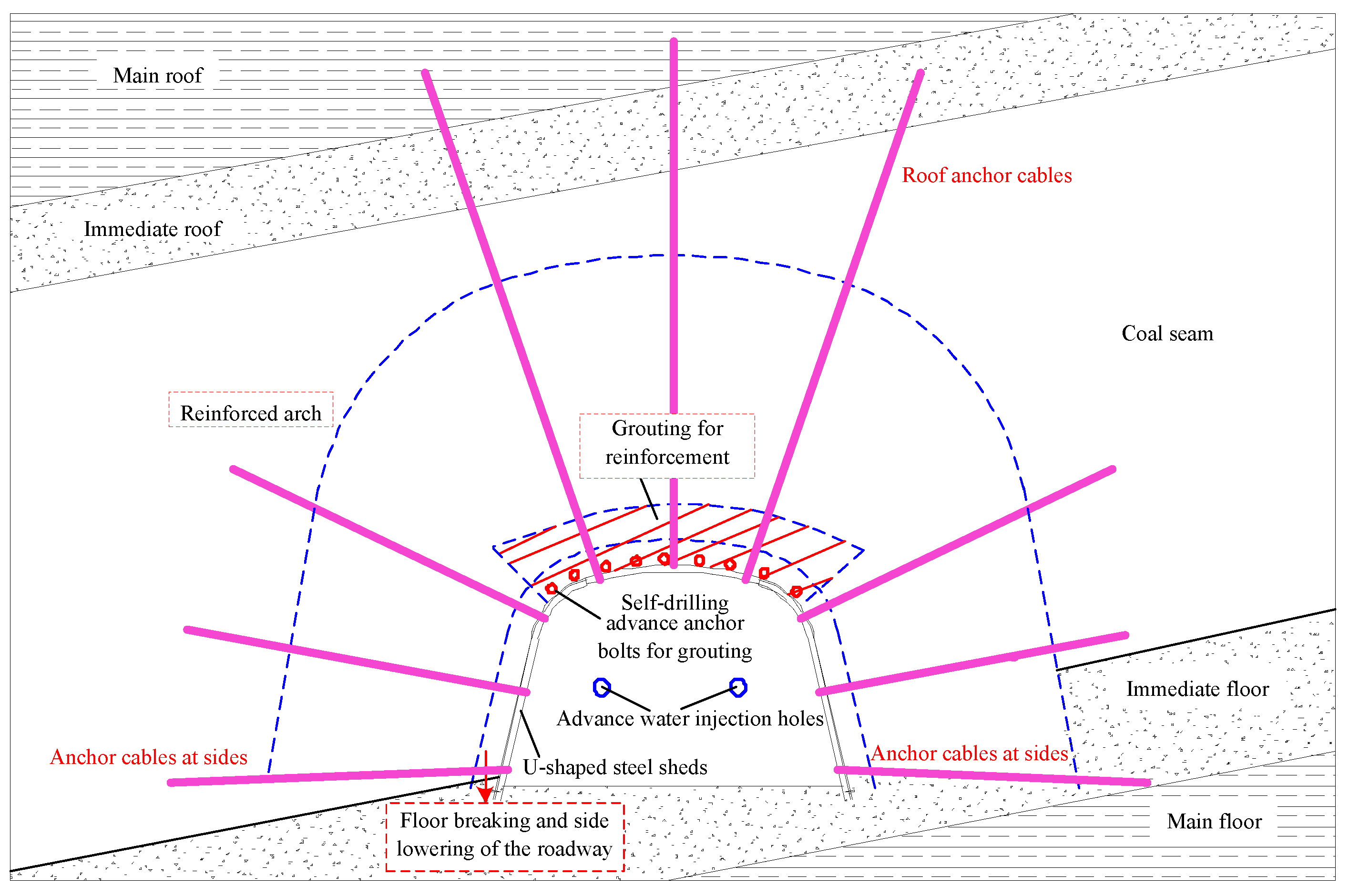
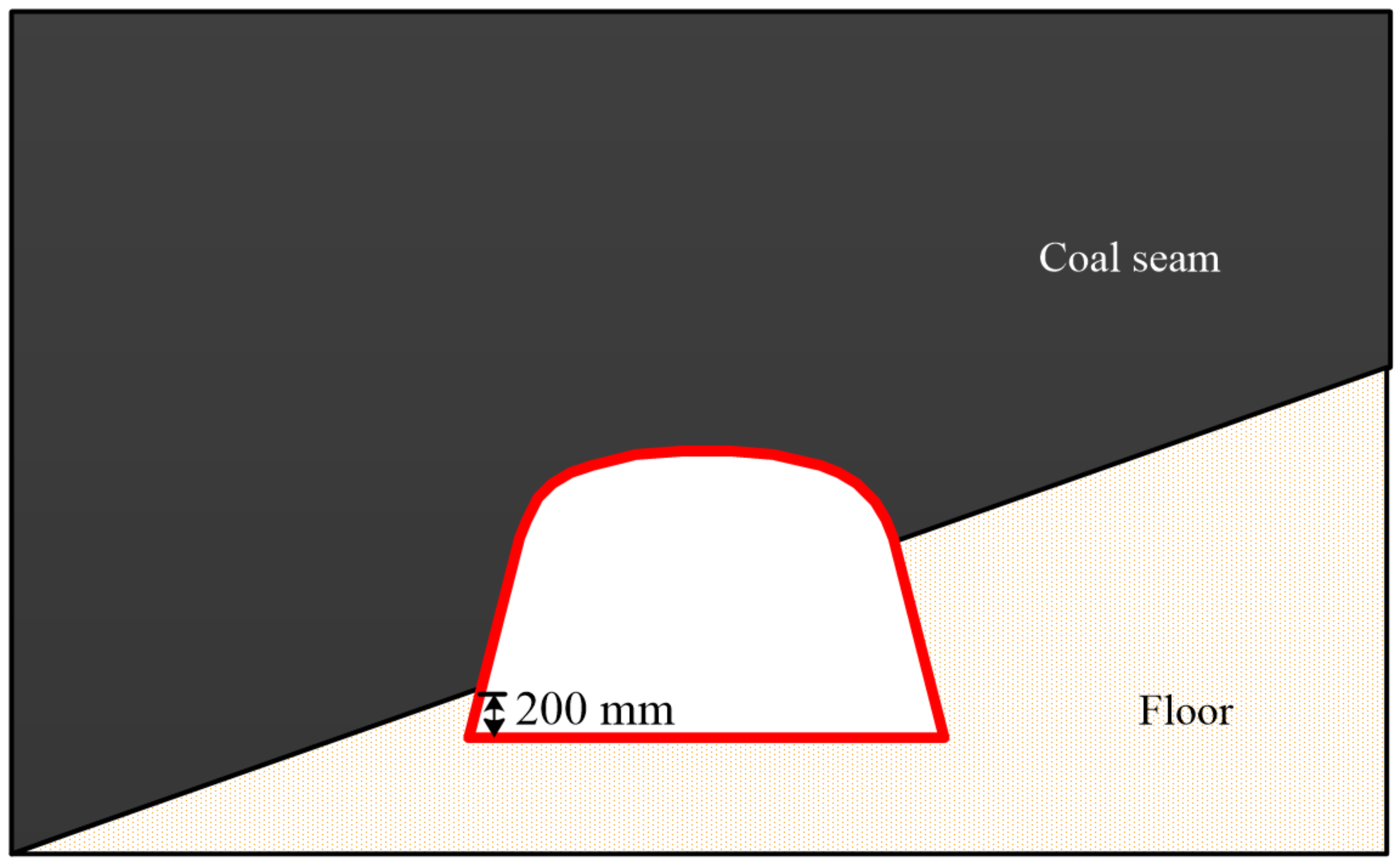
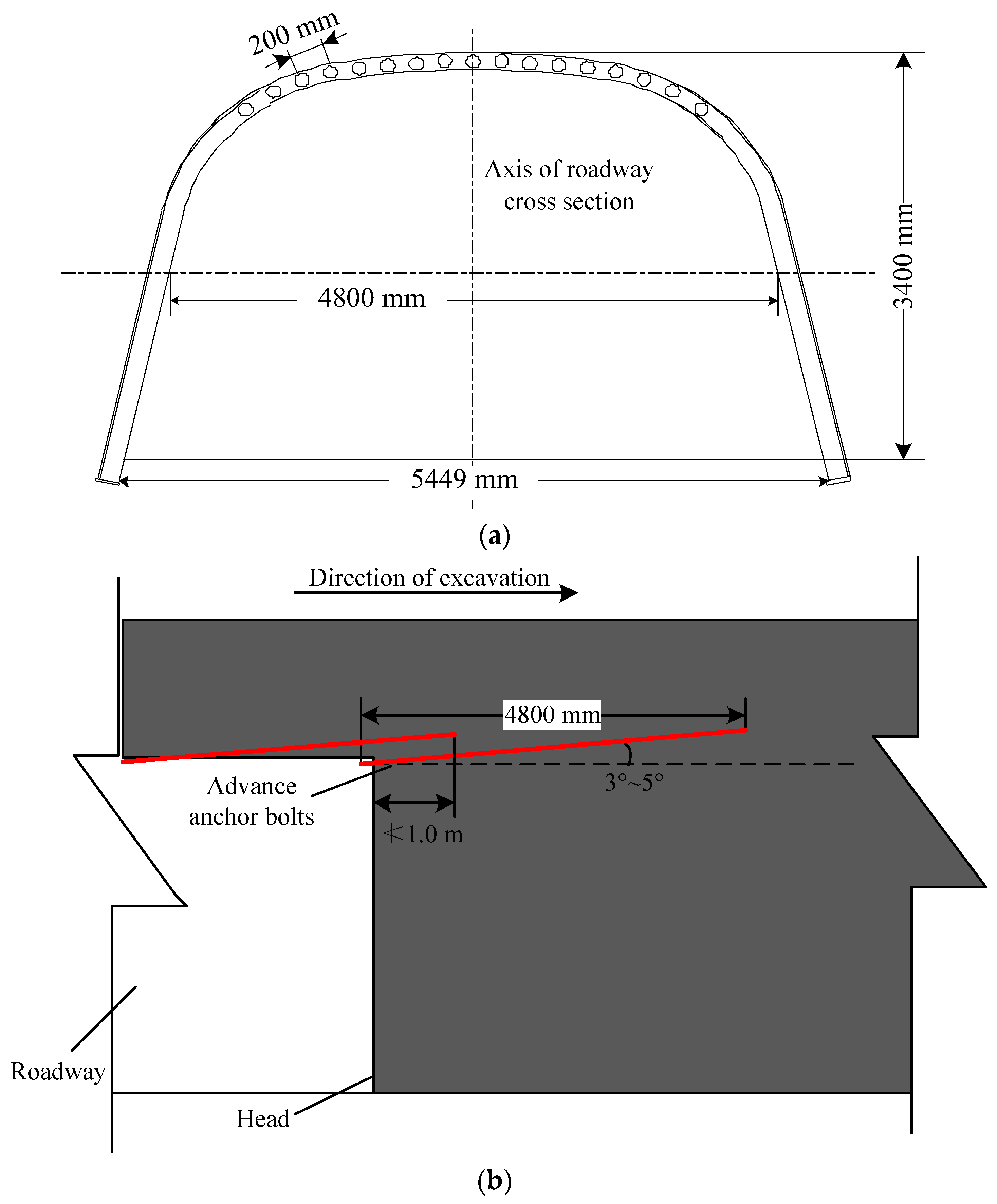


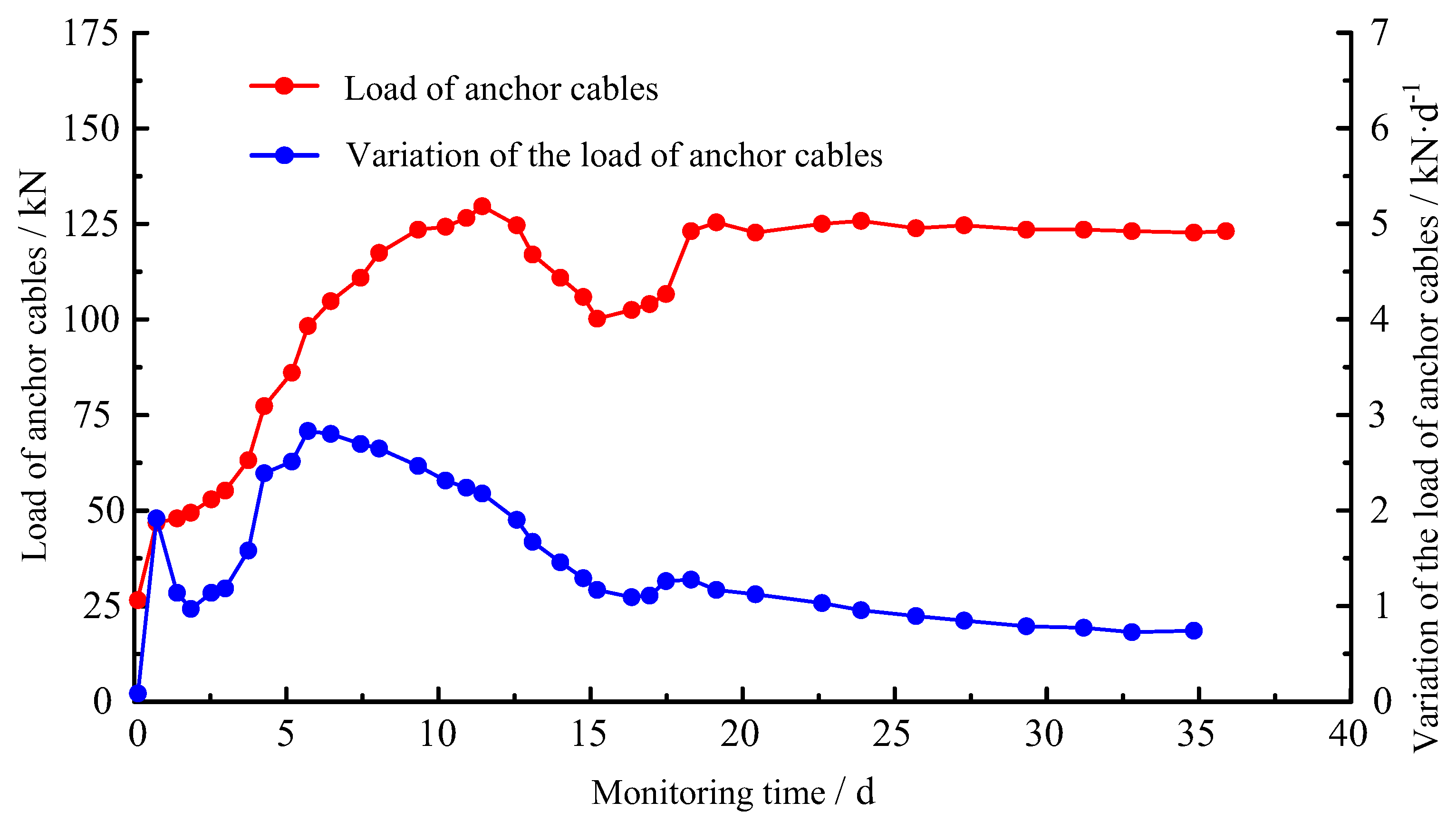


| Molecular Formula | CO3 (Substrate) | SiO2 | Al2O3 | CaO | S | Others |
|---|---|---|---|---|---|---|
| Content | 74.7% | 12.04% | 9.47% | 0.961% | 0.676% | 2.153% |
| Sample | Poisson’s Ratio | Compressive Strength/MPa | Tensile Strength/MPa | Cohesion/MPa | Internal Friction Angle/° | Elastic Modulus/GPa |
|---|---|---|---|---|---|---|
| Average value of the 8# coal seam | 0.319 | 2.23 | 0.45 | 0.21 | 22 | 2.02 |
| Average value of roof mudstone | 0.266 | 22.42 | 2.06 | 2.00 | 28 | 22.14 |
| Average value of floor mudstone | 0.267 | 17.29 | 1.30 | 1.94 | 30 | 22.35 |
Disclaimer/Publisher’s Note: The statements, opinions and data contained in all publications are solely those of the individual author(s) and contributor(s) and not of MDPI and/or the editor(s). MDPI and/or the editor(s) disclaim responsibility for any injury to people or property resulting from any ideas, methods, instructions or products referred to in the content. |
© 2024 by the authors. Licensee MDPI, Basel, Switzerland. This article is an open access article distributed under the terms and conditions of the Creative Commons Attribution (CC BY) license (https://creativecommons.org/licenses/by/4.0/).
Share and Cite
Ni, X.; Yuan, Y.; Hua, X.; Ding, K. Research and Application of the Synergistic Support System of “LDAGF” in an Extremely Soft and Fragile Fully Mechanized Caving Face Roadway. Appl. Sci. 2024, 14, 8485. https://doi.org/10.3390/app14188485
Ni X, Yuan Y, Hua X, Ding K. Research and Application of the Synergistic Support System of “LDAGF” in an Extremely Soft and Fragile Fully Mechanized Caving Face Roadway. Applied Sciences. 2024; 14(18):8485. https://doi.org/10.3390/app14188485
Chicago/Turabian StyleNi, Xianjie, Yuan Yuan, Xinzhu Hua, and Ke Ding. 2024. "Research and Application of the Synergistic Support System of “LDAGF” in an Extremely Soft and Fragile Fully Mechanized Caving Face Roadway" Applied Sciences 14, no. 18: 8485. https://doi.org/10.3390/app14188485
APA StyleNi, X., Yuan, Y., Hua, X., & Ding, K. (2024). Research and Application of the Synergistic Support System of “LDAGF” in an Extremely Soft and Fragile Fully Mechanized Caving Face Roadway. Applied Sciences, 14(18), 8485. https://doi.org/10.3390/app14188485







